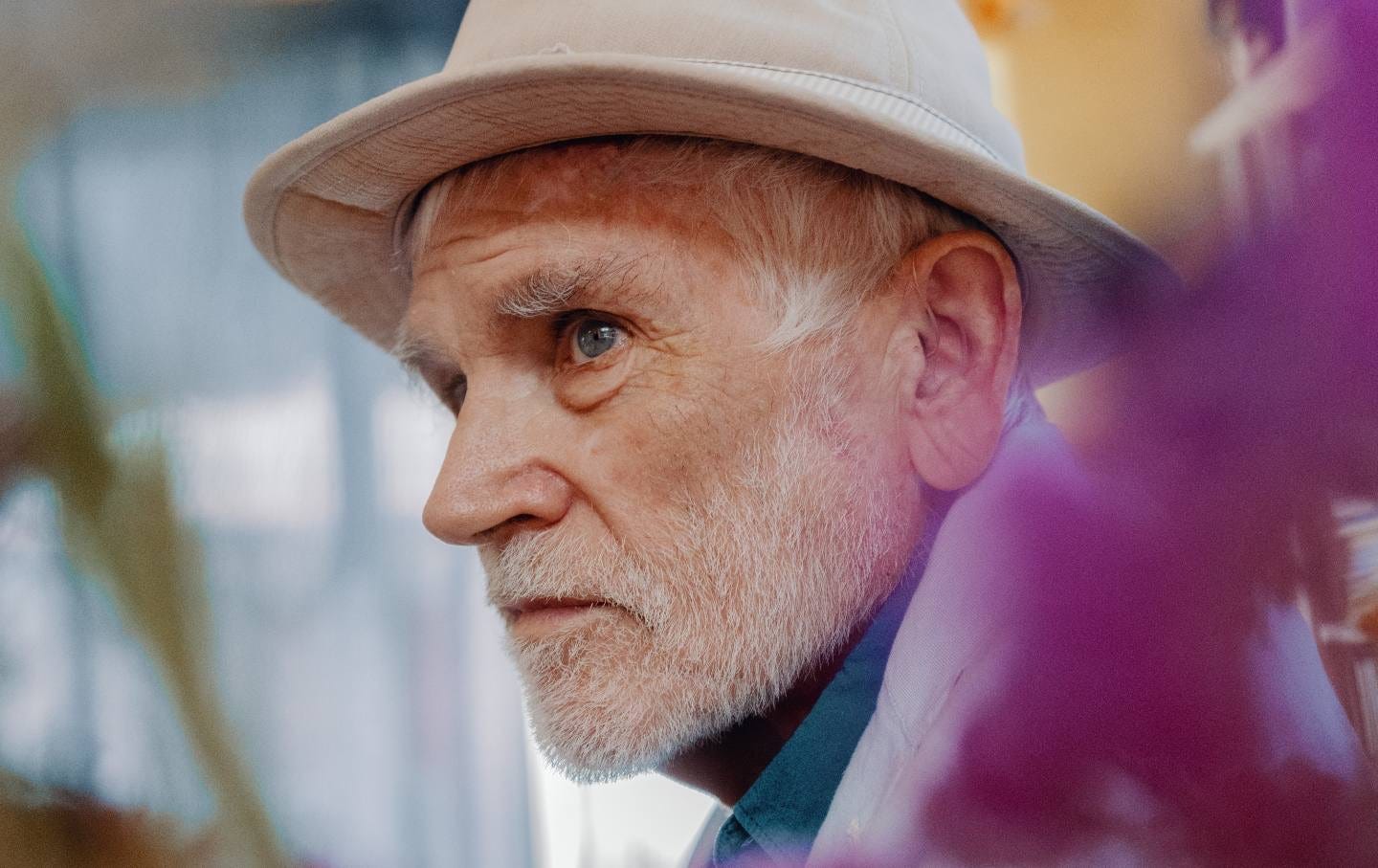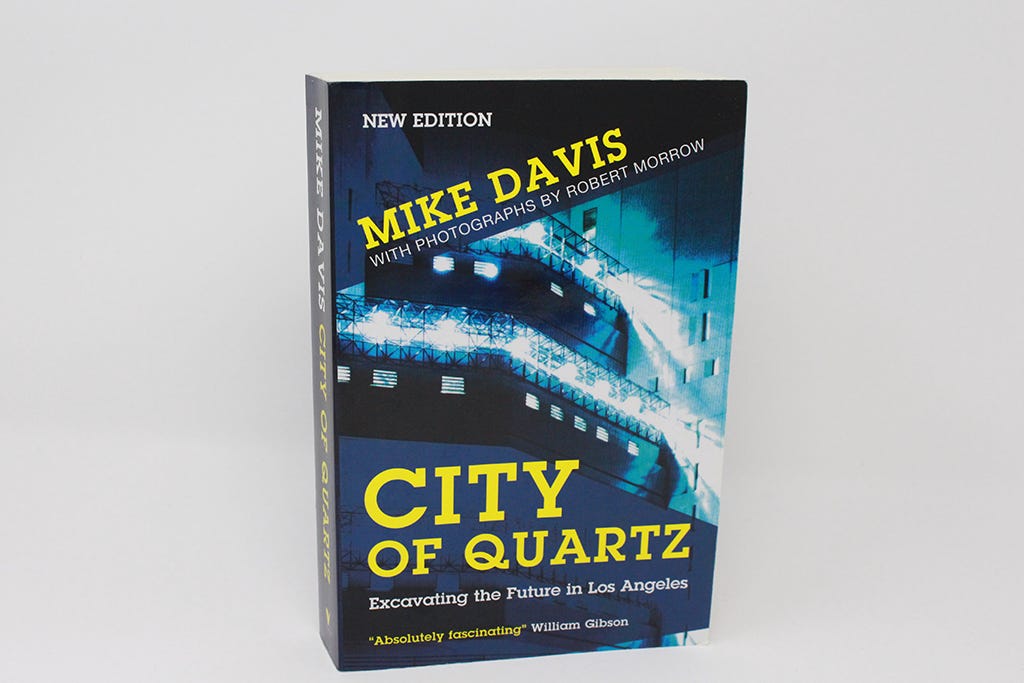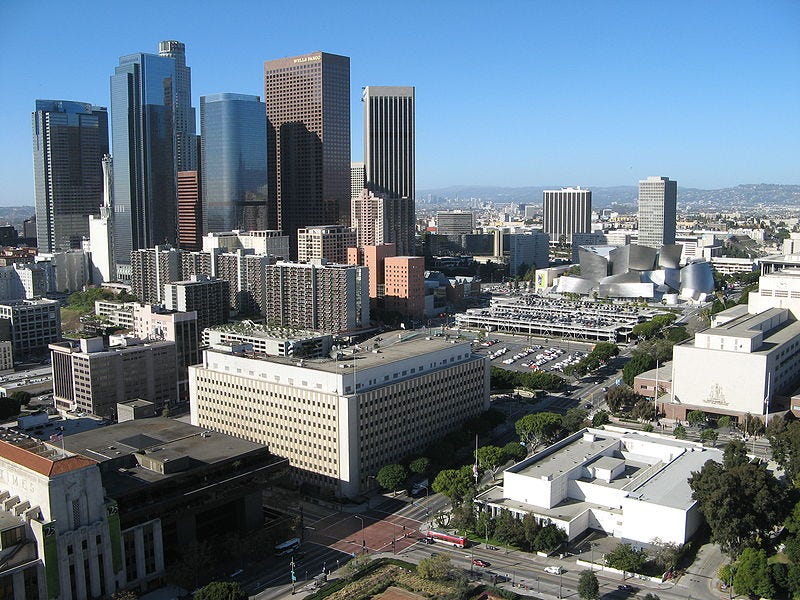Meeting Mike Davis: An origin story
How I got into politics and became a writer
After the Phillies collapsed, I combed my archives for something non-sports related and came across an ambitious and incoherent piece about City of Quartz. The following essay, which repurposes sections of that original piece, is part personal history, part book review, and part political analysis. RIP Mike Davis.
I don’t know what compelled me, on the morning of January 2, 2017, to open the Los Angeles Times’ Essential California newsletter. I had subscribed to the paper at some point, but I always ignored their emails. Maybe it was the attitude of whoever wrote the subject line:
Welcome to a new year in California
Exclamation points are for the insecure.
My life changed that morning, for the newsletter included a link to an interview with Mike Davis.
His words changed the molecular composition of my brain in real time. I didn’t know anyone like him existed. I didn’t know that kind of point of view existed. I didn’t know capitalism allowed it to. He was putting into words what I was beginning to feel about San Diego, which, in a dalliance with videography and a search for a post-Navy career, I had been walking around filming. That afternoon I started reading Davis’s masterpiece, City of Quartz.
B.D.—Before Davis—I was a soon-to-be-ex naval officer with an exercise science degree about to start an MBA program. That’s what white professionals do. A.D., I was a soon-to-be-ex naval officer on my way to becoming an urbanist, bureaucrat, and writer: a reformed jock, one that met Davis at his home a few years before his death, in 2022. City of Quartz helps explain not just my transformation, but also the place where it happened.
Depending on who you ask, Mike Davis was a city-hating socialist, a cynical communist, a chaotic Marxist, or an apocalyptic masculinist. Or he was just a bad journalist.
"I think it is fair to say his book [1998’s Ecology of Fear] is a work of imagination," historian Kevin Starr once told Salon.
"There's a pattern of poor scholarship bordering on deception," USC history professor Philip Ethington said.
And a coastal realtor, the pseudonymous Brady Westwater, crusaded against the alleged inaccuracies and inconsistencies in Davis’s footnotes. Nothing comes between a Southern Californian and their property values.
Working in politics, I have learned that if someone is complaining about process or personality, then they are losing. That is to say they don’t have power. Davis had it, and he gained it through City of Quartz: Excavating the Future in Los Angeles.
The book was a sensation upon its release in 1990 because it offended every sensibility of the political, literary, and academic establishments. It is overwritten. It is belligerent. It needs fact-checking. It is also trenchant and expansive and unsparing in its takedown of the power structures of Los Angeles and Southern California. Nothing like it had been published before.
“City of Quartz, in a nutshell, is about the contradictory impact of economic globalization upon different segments of Los Angeles society,” Davis wrote in the 2007 preface to the book. It’s the most reserved he’s ever been. City of Quartz, in a nutshell, is about calling bullshit, and it gained additional notoriety after the 1992 L.A. riots, which Davis was credited for predicting.
Davis downplayed his clairvoyance at the same time that he swung at one of his favorite punching bags, writing, “Although the owners of a certain graying newspaper on Spring Street [the Los Angeles Times] may have missed the obvious omens, every eleven-year-old in the city knew that an explosion of some kind was coming.”
Davis and the Times battled for decades after City of Quartz was published, with both sides understanding the benefits of their sparring sessions. Like two respectful boxers, they hugged each time the bell rang. “For all its warts, it is a book that needed to be written,” the Times architecture critic Christopher Hawthorne wrote in 2011. “Its era—of trickle-down economics, of Gordon Gekko, of new corporate enclaves on Bunker Hill—demanded it.”
That era, which is far from over, is gruesome: public space and services are privatized, economic inequality is the accepted norm, the homeless are permanent street refuges, the mentally impaired are jailed away without proper care, and the working class vies for the few resources the ruling class decided not to accrue for itself. Viewed from this angle, Davis’s predicting the riots was inevitable. The writing was “visible on every graffiti-covered wall.”
Davis’s is a sweeping indictment of this neoliberal order. The sunny veneer—or a triumphal gloss, as Davis put it—of post-modern, globalized Los Angeles “is laid over the brutalization of inner-city neighborhoods and the increasing South Africanization of its spatial relations. Even as the walls have come down in Eastern Europe, they are being erected all over Los Angeles.”
He names (and eviscerates) many of the forces behind this: There was the Otis-Chandler Times publishing dynasty, which was the mouthpiece of the anti-labor establishment for a half-century, but also postwar land speculators, the West Hills Property Owners Association, the Los Angeles Police Department, the Catholic Church, and even starchitect Frank Gehry. At one point, I started ducking after finishing a paragraph.
In fact, he did come after me.
When I discovered Davis and first read City of Quartz I was living in a gated community of brand-new townhomes (thank you, Navy housing stipend). It’s the kind of development Davis railed at.
The 1980s revitalization of Downtown Los Angeles which he focused on is represented by “the emerging Pacific Rim financial complex which cascades, in rows of skyscrapers, from Bunker Hill southward along the Figueroa corridor.”
Not only is its architecture undemocratic—“… the new financial district is best conceived as a single, demonically self-referential hyper-structure, a Miesian skyscape raised to dementia”—but also is its conception. “When Downtown’s new ‘Gold Coast’ is viewed en bloc from the standpoint of its interactions with other social areas and landscapes in the central city, the ‘fortress effect’ emerges, not as an inadvertent failure of design, but as a deliberate socio-spatial strategy.”
Translation: Modern development is designed to exclude, “to raze all association with Downtown’s past and to prevent any articulation with the non-Anglo urbanity of its future.” Modern development is designed only for the accumulation (and expression) of capital.
My townhome wasn’t a glass-paneled skyscraper, but it was a product of the same system of global capital. To Davis, this is what unmoors a place and the economy from the working class. With City of Quartz in my lap, I felt embarrassed by my role in the system.
I had voted Democrat all my life, and at my last duty station in the Navy the senior enlisted called me the “office hippie.” I possess none of the characteristics of a hippie. I am an aloof house cat. I guess those conservative men just didn’t like my reminding them that they’re government employees who shop at government-owned groceries stores and are treated through socialized healthcare.
Still, I lived in a gentrified home and placed a non-refundable $2,500 deposit at USC’s MBA program. It wasn’t long before I told the school I wasn’t going to show up. Some might consider that a waste of money, but I consider it a down payment on not leading the life of an asshole. (To my friends with business degrees: I love you.)
Davis also made me realize why I was seeing what I did as I walked around filming San Diego. Why one intersection was tame and humane while another was dangerous and chaotic, why one neighborhood was nice and another wasn’t, why this old building was preserved and that one wasn’t—all this indicated the power dynamics of economics, zoning, public budgets, policing, race and class, and more.
And my townhome, which was designed to keep the riff raff out, suddenly seemed to pen me in. There was no physical interface with the public sphere. I drove to work, drove back, drove for groceries, and so on. I’d take Ubers to the bars. At home, I took advantage of the creature comforts—in-unit laundry, modern appliances, HVAC, etc. Why would I walk anywhere or simply hang out in public? Lined by neither trees nor benches, sidewalks roasted in the sun and were devoid of life. It was an isolating, expensive existence.
Through some Googling and networking I found out that Davis not only was from San Diego, but that he was also a neighbor of mine. I needed to meet him, to get the solutions.
“Thanks for your kind note,” Davis wrote in response to my six-paragraph email. “I'm starting a second year of chemotherapy tomorrow (for a second cancer - long story) and am not sure how I will feel. So if you don't mind, write me in a week or ten days, and then we'll set up a time for you to drop by.”
It took 18 more months of letters and emails, but we did set up a time for me to drop by. I had prepared a list of questions and thoughts for him, but I didn’t get to them. Davis’s hearing was poor then, and after halting introductions I figured it’d be best for me to just listen. He had a story about everything. He was proud of his garage renovation, which he showed me, and he loved geology. I learned San Diego has a rock famine.
“I read strange tomes on igneous petrology and paleoclimatology,” Davis told Boom California, in the interview the Times’ newsletter linked to. “I even have a Stephen King-like text somewhere [about the street I live on] called 33rd Street Ecology because there is nothing natural in this neighborhood, from the Arundo to the Sicilian snails, which if they ever hit the Central Valley could do a few billion dollars’ damage to crops.”
A friend of Davis’s, a poet from Los Angeles, dropped by, too, and I listened to them talk shop. Davis’s wife, artist and professor Alessandra Moctezuma, ordered everyone dinner, then eventually I excused myself.
During my visit, Davis was funny, charming, prolific, and astonishingly generous. He was a sweetheart to his kids, who buzzed around the house occupying themselves as their dad entertained a nobody.
It changed how I considered his writing. He wasn’t an evil genius rolling grenades into polite society just for fun. He wasn’t recreating the Charlie Day meme trying to figure out how to overthrow capitalism. He was just a person, one who was driven to combine his heart with his talent to make a difference. It’s why he was taken aback when a journalist suggested otherwise:
He's surprised to hear that his book reveals little of his love for Los Angeles, and he's wounded by the thought. "I love Los Angeles," he says. "How can you not see that? I suppose the book is, in the end, a failure if it betrays none of the sense of deep feeling I have about the city.
When I look back at my earliest, unpublished writing—Before Davis and before my formal careers in politics and writing—all that is there are words. Even worse, there were adjectives. There was no craft, no purpose, and no heart.
If I wanted to be like Mike Davis, then I needed to stop trying to be Mike Davis, who was one of the greatest San Diegans ever and one of the most influential political thinkers in the last 35 years. That’s not because he had the best thoughts or because he expressed them the best. It’s because he threw his whole self into service.
“I’m a fatalistic Celt, and I have the example of my mother and older sister, who died like Russian soldiers at Stalingrad,” Davis told the Times a few months before his death,
But I guess what I think about the most is that I’m just extraordinarily furious and angry. If I have a regret, it’s not dying in battle or at a barricade as I’ve always romantically imagined — fighting… I’m writing because I’m hoping the people who read it don’t need dollops of hope or good endings but are reading so that they’ll know what to fight, and fight even when the fight seems hopeless.
Keep reading with a 7-day free trial
Subscribe to Out in Left to keep reading this post and get 7 days of free access to the full post archives.







